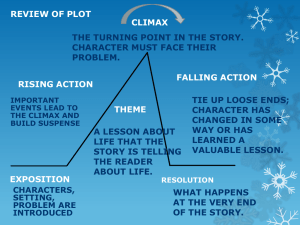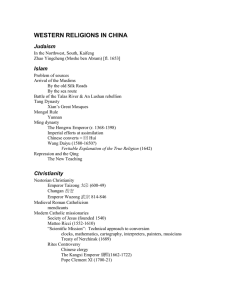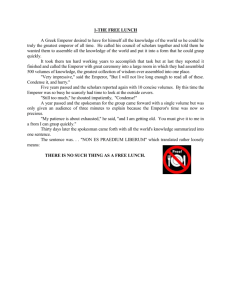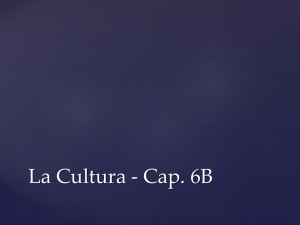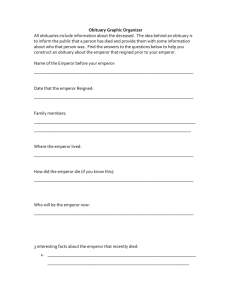Unit Cover Page Unit Title: Chinese History and Culture through
advertisement
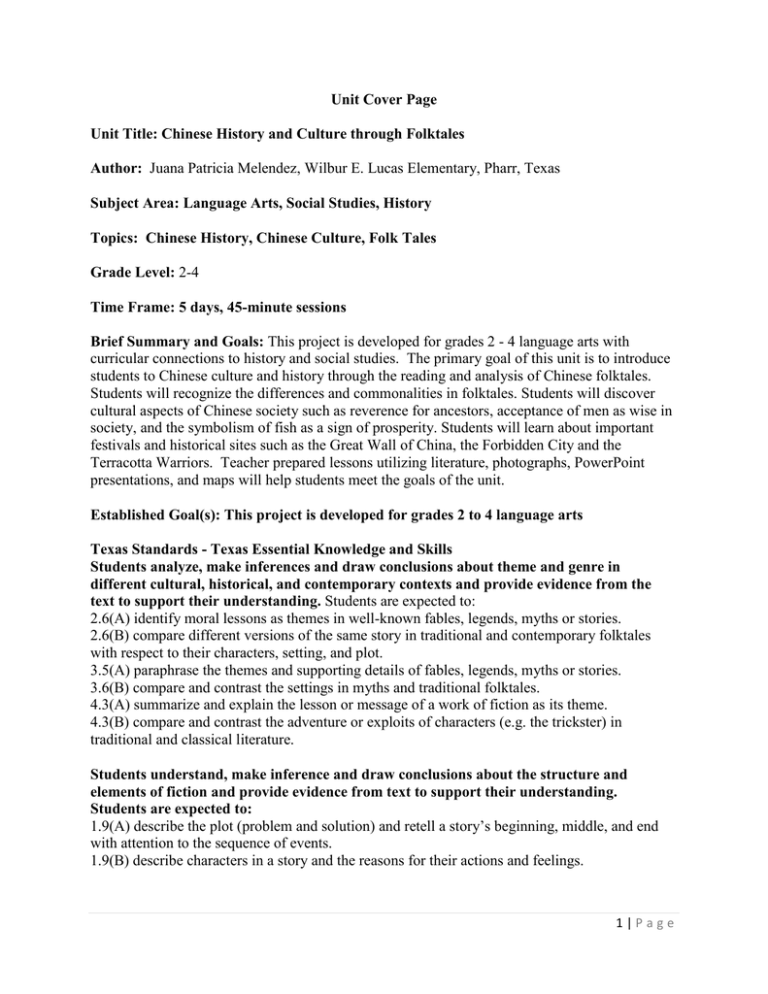
Unit Cover Page Unit Title: Chinese History and Culture through Folktales Author: Juana Patricia Melendez, Wilbur E. Lucas Elementary, Pharr, Texas Subject Area: Language Arts, Social Studies, History Topics: Chinese History, Chinese Culture, Folk Tales Grade Level: 2-4 Time Frame: 5 days, 45-minute sessions Brief Summary and Goals: This project is developed for grades 2 - 4 language arts with curricular connections to history and social studies. The primary goal of this unit is to introduce students to Chinese culture and history through the reading and analysis of Chinese folktales. Students will recognize the differences and commonalities in folktales. Students will discover cultural aspects of Chinese society such as reverence for ancestors, acceptance of men as wise in society, and the symbolism of fish as a sign of prosperity. Students will learn about important festivals and historical sites such as the Great Wall of China, the Forbidden City and the Terracotta Warriors. Teacher prepared lessons utilizing literature, photographs, PowerPoint presentations, and maps will help students meet the goals of the unit. Established Goal(s): This project is developed for grades 2 to 4 language arts Texas Standards - Texas Essential Knowledge and Skills Students analyze, make inferences and draw conclusions about theme and genre in different cultural, historical, and contemporary contexts and provide evidence from the text to support their understanding. Students are expected to: 2.6(A) identify moral lessons as themes in well-known fables, legends, myths or stories. 2.6(B) compare different versions of the same story in traditional and contemporary folktales with respect to their characters, setting, and plot. 3.5(A) paraphrase the themes and supporting details of fables, legends, myths or stories. 3.6(B) compare and contrast the settings in myths and traditional folktales. 4.3(A) summarize and explain the lesson or message of a work of fiction as its theme. 4.3(B) compare and contrast the adventure or exploits of characters (e.g. the trickster) in traditional and classical literature. Students understand, make inference and draw conclusions about the structure and elements of fiction and provide evidence from text to support their understanding. Students are expected to: 1.9(A) describe the plot (problem and solution) and retell a story’s beginning, middle, and end with attention to the sequence of events. 1.9(B) describe characters in a story and the reasons for their actions and feelings. 1|Page 2.13, 3.12, 4.10 Students analyze, make inferences and draw conclusions about the author’s purpose in cultural, historical, and contemporary contexts and provide evidence from the text to support their understanding. Students are expected to identify the topic and explain the author’s purpose in writing about the text. 3.8(A) sequence and summarize the plots’ main events and explain their influence on future events. 3.8(B) describe the interaction of characters including their relationships and the changes they undergo. 3.8(C) identify whether the narrator or speaker of a story is first or third person. Understanding(s): Folk tales can help us understand the history and culture of a country. China is located on the continent of Asia. Students will be able to locate the country on a map along with the bodies of water and countries on its borders. Students will learn the different landforms and climate of China. Essential Question(s): Where is China in relation to Texas? What are some important Chinese celebrations? How do they celebrate them? Where is the Great Wall of China? What are the Terra Cotta Warriors? What is the Forbidden City? Where is it? Performance Task(s) and Other Evidence: Students will participate in class discussions and activities Students will read Chinese folk tales Follow-up Activities: Students are encouraged to share what they learn each day with families and friends. Learning Activities: Activity 1: Lon Po Po Activity 2: Yeh-Shen: A Cinderella Story from China Activity 3: The Empty Pot Activity 4: The Seven Chinese Brothers 2|Page Lon Po Po Lesson Plan Objectives: To compare different versions of the same story in traditional folktales with respect to their characters, setting, and plot. To identify moral lesson as themes in folktales. To compare and contrast the settings in traditional folktales. To compare and contrast the adventure or exploits of characters in a folktale. To describe the plot (problem and solution) and retell a story’s beginning, middle and end with attention to sequence of events. To recognize the sequence of events in a selection. To identify cultural differences. Materials Needed: Graphic Organizers o Venn Diagram A o Story Comparison B o Story Sequence C o Problem and Solution D Sequence Sentence Activity Selection Quiz Little Red Riding Hood book Story Words: latch embrace dusk brittle cunning tender delighted 3|Page Introduce Genre A folk tale is a story that was told long ago and passed along orally. It often has a pattern of events, repeated words, and a lesson about life. Preview and Predict Have children identify title of the folk tale, the country from which it comes, the author, and the illustrator. Say: When we tell how things are alike, we compare. When we tell how they are different, we contrast. Today we will read two folk tales and look for likenesses and differences. Read “Lon Po Po” and “Little Red Riding Hood.” Use Graphic Organizer A to model compare and contrast. Write the titles above the two non-intersecting parts. Say: When I read, I look for likenesses. Both of these stories are folk tales so I will write folk tales in the part of these circles that overlap. Add folk tales to the center part. Continue adding likenesses and differences in the non-intersecting parts. Use Graphic Organizer B to compare character, setting, events, and moral in Lon Po Po and Little Red Riding Hood. Use Graphic Organizer C to model sequence of events in the selection. Use Graphic Organzier D to model identifying problem and solution in the selection. End of lesson quiz. Additional Sequence Practice: Have students scramble sentences and arrange them in correct sequence. Students may place them in the correct order on card stock or construction paper. 4|Page Directions: Cut sentence strips. Scramble and place in the correct order of events. Mother went to visit grandmother for her birthday. Three sisters stayed in the house with the doors locked. A wolf knocks on the door saying that he is “Po Po.” After a while the girls let the wolf inside the house. The wolf blows out the candle when he enters the house. Shang says, “Po Po, your foot has a bush on it.” Shang says, “Po Po, your hand has thorns on it.” Shang offers to get some ginko nuts for the wolf. The girls go outside and climb a tree to get the ginko nuts. Shang tells her sisters that Po Po is really a wolf. The wolf comes outside looking for the girls. The wolf gets in a basket so the girls can pull him up the tree to get the ginko nuts. The girls pull the basket up to the treetop. The girls drop the basket and the wolf dies. The mother came home with food for the girls 5|Page Lon Po Po Quiz 1. The women left her three children at home when she set off to _______. a. take her goods to the market b. deliver food to the children’s father c. take care of a neighbor who is ill d. visit the children’s grandmother on her birthday 2. When Tao and Paotze opened the door, what did the wolf do? a. He covered his face and pretended to weep. b. He blew out the candle. c. He gave the children candy. d. He grabbed Shang. 3. Shang told the wolf that tasting a ginko nut would make him ______________. a. live forever b. think wise thoughts c. have good fortune d. sleep like a baby 4. What did the wolf do after the three sisters let go of the rope? a. He bumped his head and broke his heart to pieces. b. He ran away after the sisters threw ginko nuts at him. c. He stole a chicken and went back to his den. d. He crawled out of the basket and limped into the woods. 5. After discovering the wolf dead, the children ________. a. ran all the way to their real Po Po’s home b. buried the wolf under the ginko tree c. celebrated by singing and dancing into the night d. locked the door of the house and fell peacefully asleep 6|Page Lon Po Po Quiz-Answer Key 1. The women left her three children at home when she set off to _______. a. take her goods to the market b. deliver food to the children’s father c. take care of a neighbor who is ill d. visit the children’s grandmother on her birthday 2. When Tao and Paotze opened the door, what did the wolf do? a. He covered his face and pretended to weep. b. He blew out the candle. c. He gave the children candy. d. He grabbed Shang. 3. Shang told the wolf that tasting a ginko nut would make him ______________. a. live forever b. think wise thoughts c. have good fortune d. sleep like a baby 4. What a. b. c. d. did the wolf do after the three sisters let go of the rope? He bumped his head and broke his heart to pieces. He ran away after the sisters threw ginko nuts at him. He stole a chicken and went back to his den. He crawled out of the basket and limped into the woods. 5. After a. b. c. d. discovering the wolf dead, the children ________. ran all the way to their real Po Po’s home buried the wolf under the ginko tree celebrated by singing and dancing into the night locked the door of the house and fell peacefully asleep 7|Page Yeh-Shen: A Chinese Cinderella Story Objectives: To compare different versions of the same story in traditional folktales with respect to their character, setting, and plot. To identify moral lesson as theme in folktales. To compare and contrast the setting in traditional folktales. To compare and contrast the adventure or exploits of characters in a folktale. To describe the plot (problem and solution) and retell a story’s beginning, middle and end with attention to sequence of events. To recognize the sequence of events in a selection. To identify cultural differences. Materials Needed: Graphic Organizer o Venn Diagram A o Story Comparison B o Story Sequence C o Problem and Solution D Sequence Sentence Activity Selection Quiz Cinderella Book Story Words: orphan ivory unpleasant gown custom jealous determined wondrous transformation delighted 8|Page Introduce Genre A folktale is a story that was told long ago and passed along orally. It often has a pattern of events, repeated words, and a lesson about life. Preview and Predict Have children identify title of the folktale, the country from which it comes, the author, and the illustrator. Say: When we tell how things are alike, we compare. When we tell how they are different, we contrast. Today we will read two folk tales and look for likenesses and differences. Read “Yeh-Shen: A Cinderella Story from China” and “Cinderella.” Use Graphic Organizer A to model compare and contrast. Write the titles above the two non-intersecting parts. Say: When I read, I look for likenesses. Both of these stories are folk tales so I will write folk tales in the part of these circles that overlap. Add folk tales to the center part. Continue adding likenesses and differences in the non-intersecting parts. Use Graphic Organizer B to compare characters, setting, events, and moral in Yeh-Shen and Cinderella. Use Graphic Organizer C to model sequence of events in the selection. Use Graphic Organizer D to model identifying problem and solution in the selection. End of lesson quiz. Additional Sequence Practice: Have students scramble sentences and arrange them in correct sequence. Students may place them in the correct order on card stock or construction paper. 9|Page Directions: Cut sentence strips. Scramble and place in the correct order of events. Yeh-Shen’s father died and she became an orphan. Yeh-Shen grew up with her stepmother. Yeh-Shen’s only friend was a fish she had caught and raised. The stepmother caught and cooked the fish for dinner. A man appeared and told Yeh-Shen about the wondrous powers of the fish. The festival arrived. The stepmother ordered Yeh-Shen to stay home. Yeh-Shen asked the fish spirit for something to wear to the festival. Yeh-Shen ran away from the festival and lost a golden slipper. A merchant gave the King the lost golden slipper. The king wanted to find the owner of the golden slipper. The king and his men waited in a hiding place for the owner of the golden slipper. The king and his men followed Yeh-Shen home. The king fell in love with Yeh-Shen when he saw in the beautiful azure gown. Yeh-Shen’s stepmother and stepsister were crushed to death in a shower of flying stones. 10 | P a g e Yeh-Shen Quiz 1. What did the fish do every day? a. It b. It c. It d. It showed Yeh-Shen how to sing. waited to be fed by Yeh-Shen. sang to Yeh-Shen. swam in circles when Yeh-Shen sang. 2. How did Yeh-Shen’s stepmother trick the fish? a. She b. She c. She d. She sang Yeh-Shen’s favorite song. wore Yeh-Shen’s jacket to the pond. used a net to catch the fish. fed him at night when the fish couldn’t see. 3. Who told Yeh-Shen about the special secret of her fish? a. her stepmother b. a beautiful woman c. an old man d. the king 4. The fish bones were filled with ____________. a. a powerful spirit b. gold c. her mother’s love d. knowledge of the future 5. What did Yeh-Shen’s stepmother tell her to do during the Festival Banquet? a. watch to see that no one stole fruit from the trees b. find a husband c. prepare a cheese and meat tray for the festival d. go to the festival and dance with everyone 11 | P a g e 6. What was magical about Yeh-Shen’s slippers? a. They b. They c. They d. They taught her to dance. felt light as air. were made of glass. were ruby slippers. 7. The fish bones were silent when __________. a. Yeh-Shen married the king. b. Yeh-Shen fell down the mountain. c. the old man appeared. d. Yeh-Shen lost one of the slippers. 8. The king placed the sandal in a roadside pavilion to _____. a. scare away the evil spirits b. try to find the rightful owner c. catch a thief d. display it for all to admire 9. What was the king’s first thought when he saw Yeh-Shen pick up the sandal? a. to make her his bride b. that she was the one he saw at the festival c. that she looked sad and hungry d. to throw her into prison as a thief 10. What was the fate of Yeh-Shen’s stepmother and stepsister? a. They were banished from the kingdom. b. They went to live with Yeh-Shen and the king. c. They became the king’s slaves. d. They were crushed in a shower of flying stones. 12 | P a g e Yeh-Shen Quiz-Answer Key 1. What did the fish do every day? a. It showed Yeh-Shen how to sing. b. It waited to be fed by Yeh-Shen. c. It sang to Yeh-Shen. d. It swam in circles when Yeh-Shen sang. 2. How did Yeh-Shen’s stepmother trick the fish? a. She sang Yeh-Shen’s favorite song. b. She wore Yeh-Shen’s jacket to the pond. c. She used a net to catch the fish. d. She fed him at night when the fish couldn’t see. 3. Who told Yeh-Shen about the special secret of her fish? a. b. c. d. her stepmother a beautiful woman an old man the king 4. The fish bones were filled with ____________. a. a powerful spirit b. gold c. her mother’s love d. knowledge of the future 5. What did Yeh-Shen’s stepmother tell her to do during the Festival Banquet? a. watch to see that no one stole fruit from the trees b. find a husband c. prepare a cheese and meat tray for the festival d. go to the festival and dance with everyone 13 | P a g e 6. What was magical about yeh-Shen’s slippers? a. They taught her to dance. b. They felt light as air. c. They were made of glass. d. They were ruby slippers. 7. The fish bones were silent when __________. a. Yeh-Shen married the king. b. Yeh-Shen fell down the mountain. c. the old man appeared. d. Yeh-Shen lost one of the slippers. 8. The king placed the sandal in a roadside pavilion to _____. a. scare away the evil spirits b. try to find the rightful owner c. catch a thief d. display it for all to admire 9. What was the king’s first thought when he saw Yeh-Shen pick up the sandal? a. to make her his bride b. that she was the one he saw at the festival c. that she looked sad and hungry d. to throw her into prison as a thief 10. What was the fate of Yeh-Shen’s stepmother and stepsister? a. They were banished from the kingdom. b. They went to live with Yeh-Shen and the king. c. They became the king’s slaves. d. They were crushed in a shower of flying stones. 14 | P a g e The Empty Pot Lesson Plan Objectives: To identify moral lesson as themes in folktales. To describe the plot (problem and solution) and retell a story’s beginning, middle and end with attention to sequence of events. To put events in a sequence To identify cultural and historical places (e.g. The Forbidden City) Materials Needed: Graphic Organizers o Story Elements B o Story Sequence C o Problem and Solution D Sequence Activity Selection Quiz The Empty Pot, by Demi Story Words: Emperor successor proclamation soil sprout Introduce Genre A folk tale is a story that was told long ago and passed along orally. It often has a pattern of events, repeated words, and a lesson about life. Preview and Predict Have children identify title of the folk tale, the country from which it comes, the author, and the illustrator. 15 | P a g e Say: Today we will read a story about a young boy named Ping. Ping loves gardening and grows beautiful plants and flowers. An aging Emperor needs to find a successor to the throne. An emperor is like a king, who rules the land. We will learn how the emperor chooses his replacement. Direct students to place close attention to the details and illustrations to find out how the Emperor picks his replacement. Engage in an interactive read aloud. Show illustrations and ask students, “What does the author tell us about Ping? (Ping loves flowers. Ping is extremely good at growing flowers.) What does Ping do with the seed? (He plants it very carefully in a flowerpot filled with rich soil.) What does Ping do when the seed does not grow? (He put new soil into a bigger pot. He puts the seed into the new rich soil in the bigger pot). What have other children brought the emperor? (They have brought beautiful flowers.) What does the emperor do when he sees the beautiful flowers the other kids have brought? (He frowns.) What had Ping brought to the emperor? (An empty pot.) What does the emperor say about the seeds he gave the children? (He says they have been cooked and that it was impossible for them to grow.) Why does the emperor choose Ping to be his successor? (Ping showed courage by bringing the empty pot. Ping was also honest.) Use Graphic Organizer B to identify the characters, setting, events, and moral of the folktale. Use Graphic Organizer C to model sequence of events in the selection. Use Graphic Organizer D to model identifying problem and solutions presented. End of lesson quiz Additional Sequence Practice: Have students scramble sentences and arrange them in correct sequence. Students may place them in the correct order on card stock or construction paper. 16 | P a g e Directions: Cut sentence strips. Scramble and place in the correct order of events. The Emperor needs to find someone to replace him. All the children in the land were given a special flower seed by the emperor. Ping planted his seed in rich soil but it did not grow. Ping planted the seed in a bigger pot with richer soil but the seed did not grow. All the kids took beautiful flowers to the emperor. Ping took an empty pot because his seed did not grow. The emperor looked at the beautiful flowers and frowned. Ping told the Emperor that the empty pot was the best he could do. The Emperor admired Ping’s honesty and made him his successor. The Emperor tells the children that he had given them baked seeds and it was impossible for them to grow. 17 | P a g e The Empty Pot Quiz 1. The Emperor of what country made an announcement? a. China b. Japan c. Saudi Arabia d. Europe 2. Who did the Emperor need to find? a. A new wife. b. His lost son. c. Someone to replace him. d. His father. 3. Who was going to help chose the Emperor’s successor? a. The flowers. b. His guards. c. The people he ruled. d. His wife. 4. What did the boys get from the palace? a. A gift b. A flower seed c. A pot d. Soil 5. What happened to Ping’s seed? a. Nothing. b. It grew into a beautiful flower. c. It grew into a flower but died. d. He lost it. 18 | P a g e 6. Why was Ping worried? a. Nothing grew in the pot. b. The flower died. c. The flower looked ugly. d. The flower was too small. 7. What did Ping bring to the palace? a. A tree b. A beautiful flower c. An empty pot d. Nothing 8. What did the Emperor do when he saw all the beautiful flowers? a. He frowned. b. He was happy. c. He gave all the boys a gift. d. He did not like any of them. 9. How did the Emperor reward Ping’s honesty? a. He made him Emperor of all the land. b. He sent him on a trip around the world. c. He was given a new house. d. He gave him a beautiful flower. 10. Why did the seeds not sprout? a. They were cooked. b. They were old. c. He didn’t put enough water. d. He put too much water. 19 | P a g e The Empty Pot Quiz-Answer Key 1. The Emperor of what country made an announcement? a. China b. Japan c. Saudi Arabia d. Europe 2. Who did the Emperor need to find? a. b. c. d. A new wife. His lost son. Someone to replace him. His father. 3. Who was going to help chose the Emperor’s successor? a. The flowers. b. His guards. c. The people he ruled. d. His wife. 4. What did the boys get from the palace? a. A gift b. A flower seed c. A pot d. Soil 5. What happened to Ping’s seed? a. Nothing b. It grew into a beautiful flower. c. It grew into a flower but died. d. He lost it. 20 | P a g e 6. Why was Ping worried? a. Nothing grew in the pot. b. The flower died. c. The flower looked ugly. d. The flower was too small. 7. What did Ping bring to the palace? a. b. c. d. A tree. A beautiful flower. An empty pot. Nothing 8.What did the Emperor do when he saw all the beautiful flowers? a. He frowned. b. He was happy. c. He gave all the boys a gift. d. He did not like any of them. 9. How did the Emperor reward Ping’s honesty? a. He made him Emperor of all the land. b. He sent him on a trip around the world. c. He was given a new house. d. He gave him a beautiful flower. 10. Why did the seeds not sprout? a. They were cooked. b. They were old. c. He didn’t put enough water. d. He put too much water. 21 | P a g e The Seven Chinese Brothers Lesson Plan Objectives: To identify moral lesson as themes in folktales. To describe the plot (problem and solution) and retell a story’s beginning, middle and end with attention to sequence of events. To recognize the sequence of events in a selection To identify cultural and historical places (e.g. The Great Wall of China) Materials Needed: Graphic Organizers o Story Elements B o Story Sequence C o Problem and Solution D Sequence Activity Selection Quiz The Seven Chinese Brothers book Story Words: splendid mighty swept emperor dazzling worms beak stretched fluffy yelled Introduce Genre A folk tale is a story that was told long ago and passed along orally. It often has a pattern of events, repeated words, and a lesson about life. 22 | P a g e Preview and Predict Have children identify title of the folk tale, the country from which it comes, the author, and the illustrator. Before reading The Seven Chinese Brothers, share information about the construction of the Great Wall of China. Show pictures of the Great Wall to your students and explain that the Great Wall is considered one of the 7 manmade Wonders of the World. The wall was built to defend the Chinese empire from invaders, and it was built by laborers who were not paid. Say: Today we will read a folktale about seven brothers who work together to trick a mean emperor. Direct students to place close attention to the details and illustrations to find out how the brothers are able to trick the emperor. Engage in an interactive read aloud. Show illustrations and ask students, “What amazing and impossible power did each brother have? How did the brothers trick the emperor? Why didn’t the emperor realize the brothers were changing places? How did the brothers work as a team?” Use Graphic Organizer B to identify the characters, setting, events, and moral of the folktale. Use Graphic Organizer C to model sequence of events in the selection. Use Graphic Organizer D to model identifying problem and solutions presented. End of lesson quiz Additional Sequence Practice: Have students scramble sentences and arrange them in correct sequence. Students may place them in the correct order on card stock or construction paper. 23 | P a g e Directions: Cut sentence strips. Scramble and place in the correct order of events. The poor men had to work day and night to fix the Wall of China. The third brother was caught by the Emperor’s guards and taken to the palace. The fourth brother was going to be drowned by the Emperor. The fifth brother was going to be burned by the Emperor. The sixth brother was going to be shot full of arrows by the Emperor. The seventh brother cried sending the Emperor’s army to the north and to the south. The brothers were reunited at the Great Wall of China. The seven brothers feasted on delicious fried fish. 24 | P a g e The Seven Chinese Brothers Quiz 1. Each brother had an amazing _________. a. power b. journey c. fortune d. friend 2. Why did all the brothers try to keep the Seventh Brother happy? a. When he was sad, all the other brothers became sad for many days. b. When he became angry, his steel fists could smash a house or tree. c. He was the baby and still acted and talked like a baby. d. He wept with big salt tears that could drown the village. 3. Why was the emperor worried? a. The enormous hole in the Great Wall of China could not be fixed. b. It took one hundred men working forty days to plug up the hole in the wall. c. His two armies were lost after crossing the Great Wall of China. d. He thought the Third Brother might be too strong. 4. The brothers decided they would all be together to be ____. a. shot with arrows b. burned in the emperor’s fire c. drowned d. beheaded 5. Where were the brothers reunited? a. at the Great Wall b. outside the army camp c. in the Yellow Sea d. in the emperor’s palace 25 | P a g e The Seven Chinese Brothers Quiz-Answer Key 1. Each a. b. c. d. brother had an amazing _________. power journey fortune friend 2. Why did all the brothers try to keep the Seventh Brother happy? a. When he was sad, all the other brothers became sad for many days. b. When he became angry, his steel fists could smash a house or tree. c. He was the baby and still acted and talked like a baby. d. He wept with big salt tears that could drown the village. 3. Why was the emperor worried? a. The enormous hole in the Great Wall of China could not be fixed. b. It took one hundred men working forty days to plug up the hole in the wall. c. His two armies were lost after crossing the Great Wall of China. d. He thought the Third Brother might be too strong. 4. The brothers decided they would all be together to be ____. a. shot with arrows b. burned in the emperor’s fire c. drowned d. beheaded 5. Where were the brothers reunited? a. at the Great Wall b. outside the army camp c. in the Yellow Sea d. in the emperor’s palace 26 | P a g e References Ai-Ling, L., & Young, E. (1999). Yeh-Shen: A Cinderella Story from China. New York, New York: Puffin Books. Demi, D. (1992). The Empty Pot. Boston, MA: Houghton Mifflin Harcourt. Mahy, M., & Tseng, J. (1990). The Seven Chinese brothers. New York, NY: Scholastic. Young, E. (1996). Lon Po Po: A Red-Riding Hood Story from China. New York, New York: Penguin Putnam Books for Young Readers. 27 | P a g e Name: __________________________ Graphic Organizer C Title: ________________________________________ Beginning Middle End 28 | P a g e Name: _____________________________ Graphic Organizer D Title: _______________________________ Problem Solution 29 | P a g e Name: ________________________________ ____________________ Graphic Organizer A ____________________ 30 | P a g e Story 1: ______________________________________________________ Characters Setting Events Graphic Organizer B Moral Story 2: _______________________________________________________ Characters Setting Events Moral 31 | P a g e
